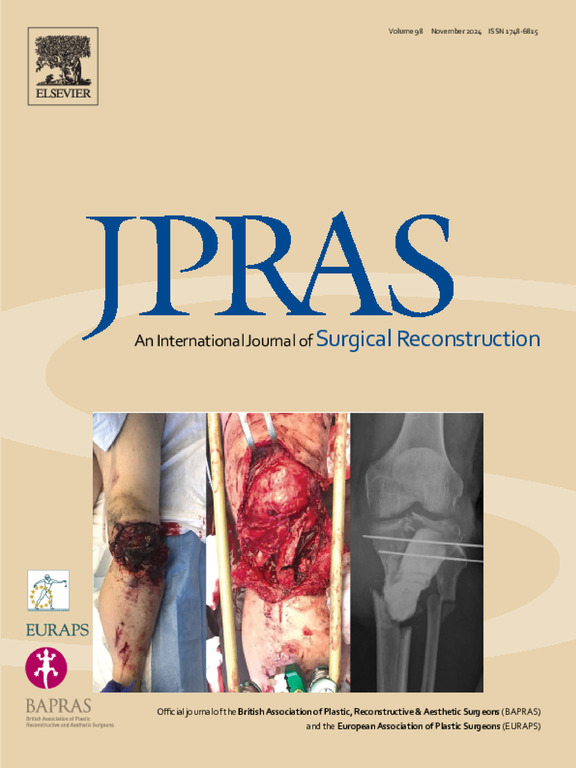Pain relief after surgical neurolysis in Gazan patients with peripheral nerve injuries: A report amidst the ongoing conflict
IF 2.4
3区 医学
Q2 SURGERY
Journal of Plastic Reconstructive and Aesthetic Surgery
Pub Date : 2025-07-03
DOI:10.1016/j.bjps.2025.06.024
引用次数: 0
Abstract
Introduction
Neuropathic pain from peripheral nerve injuries (PNIs) poses a major challenge, especially in conflict zones. Surgical neurolysis is a known intervention for pain due to nerve scarring and compression, but its impact in resource-limited settings remains underreported. This study evaluates pain outcomes following neurolysis in a conflict-affected region.
Methods
A prospective case series was conducted in three major hospitals in Gaza from May to August 2024. Patients with severe neuropathic pain (VAS >7) persisting >3 months despite medical therapy underwent neurolysis by a single peripheral nerve surgeon. Data included demographics, injury mechanisms, operative findings, and VAS scores preoperatively and at 2 weeks and 3 months postoperatively. Analgesic use and statistical significance (p<0.05) were analyzed using SPSS.
Results
Seventy-five patients (62 males, 13 females; mean age 31.2 years) were included. Injuries were caused by shrapnel (80%) and gunshots (16%). Mean VAS score decreased from 9.2 (SD 1.2) preoperatively to 2.9 (SD 2.7) at 2 weeks and 2.7 (SD 2.5) at 3 months (p<0.001), representing 68% and 71% reductions, respectively. Analgesic use dropped from 73% preoperatively to 8% at 3 months. No significant differences were noted based on age, sex, or nerve affected. Pain reduction >2 points on the VAS, the threshold for clinical significance per EFNS guidelines, was achieved in 94.7% of patients.
Conclusion
Surgical neurolysis significantly reduces neuropathic pain and analgesic reliance in PNI patients, highlighting its effectiveness and the need to expand surgical capacity in conflict zones.
加沙周围神经损伤患者手术神经松解术后疼痛缓解:持续冲突中的一份报告。
导语:周围神经损伤(PNIs)引起的神经性疼痛是一个重大挑战,特别是在冲突地区。手术神经松解术是治疗神经瘢痕和压迫引起的疼痛的一种已知干预措施,但在资源有限的情况下,其影响仍未得到充分报道。本研究评估了冲突影响区域神经松解后的疼痛结果。方法:于2024年5月至8月在加沙三家主要医院进行前瞻性病例系列研究。患者严重神经性疼痛(VAS bbb7)持续>3个月,尽管药物治疗行神经松解术。数据包括术前、术后2周和3个月的人口统计学、损伤机制、手术结果和VAS评分。结果:75例患者(男62例,女13例;平均年龄31.2岁)。伤由弹片(80%)和枪击(16%)造成。平均VAS评分从术前9.2分(SD 1.2)下降到2周时的2.9分(SD 2.7)和3个月时的2.7分(VAS评分为p2分,根据EFNS指南达到临床意义的阈值),94.7%的患者达到VAS评分。结论:手术神经松解术可显著减少PNI患者的神经性疼痛和镇痛依赖,强调其有效性和在冲突地区扩大手术能力的必要性。
本文章由计算机程序翻译,如有差异,请以英文原文为准。
求助全文
约1分钟内获得全文
求助全文
来源期刊
CiteScore
3.10
自引率
11.10%
发文量
578
审稿时长
3.5 months
期刊介绍:
JPRAS An International Journal of Surgical Reconstruction is one of the world''s leading international journals, covering all the reconstructive and aesthetic aspects of plastic surgery.
The journal presents the latest surgical procedures with audit and outcome studies of new and established techniques in plastic surgery including: cleft lip and palate and other heads and neck surgery, hand surgery, lower limb trauma, burns, skin cancer, breast surgery and aesthetic surgery.

 求助内容:
求助内容: 应助结果提醒方式:
应助结果提醒方式:


